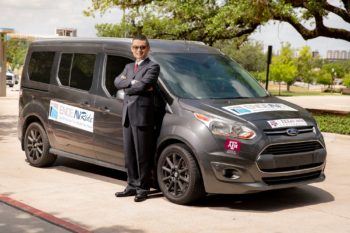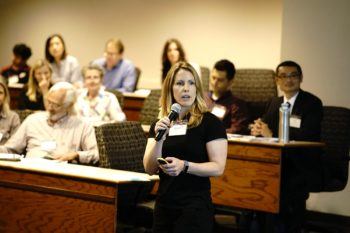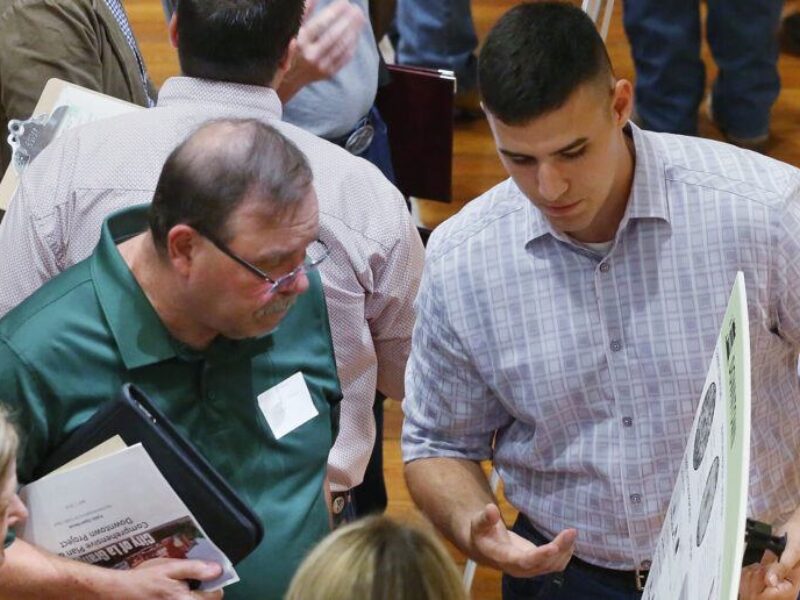Nolanville’s ‘Smart’ Future
“Smart” cities. They’re places that promise big improvements in important areas: better traffic flow, improved public safety, better optimized utility systems, and many other public benefits from an extensive, high-bandwidth digital network.
But this vision invariably refers to large cities with resources to invest in expensive software and infrastructure. Could “smart” technology also improve life in smaller towns?
It’s a question that Wei Li, Texas A&M associate professor of urban planning, is answering with ENDEAVR — an ambitious project he’s leading in which more than 120 students from a wide range of university degree programs in collaboration with residents of Nolanville, a small Central Texas town 10 miles east of Killeen. The project aims to help the town take its first “smart” city steps.
Nolanville’s forward-thinking residents have embraced the partnership.
“Working toward being a ‘smart’ city gives us an identity we didn’t have before,” said Nolanville City Manager Kara Escajeda. “It means everything in the way of providing a cohesive vision and plan for our community to work toward.”
Li launched ENDEAVR in 2018 with a $300,000 grant from the Keck Foundation, which supports projects that promote inventive educational approaches. At the project’s outset, students majoring in urban planning, landscape architecture, visualization, computer science, and civil, electrical and mechanical engineering gathered in seminars that covered the history of city development and learned how to shape proposals that spring from groups in different disciplines.
These seminars also prepared them for an intensive envisioning process with Nolanville residents, who provided ENDEAVR students with specific ideas about improvements and concerns about their community.
At the end of the Spring 2020 semester, students virtually presented their “smart” city ideas to Nolanville residents.
Escajeda, the city manager, was especially intrigued by students’ concepts of a train notification system. Train tracks run through the middle of town, regularly causing delays and frustration for Nolanville motorists. “A couple of teams came up with notification system ideas, including an app-based alert system,” Escajeda said.
Another group proposed a district that would incentivize the establishment of high-tech startups or established companies. “One team proposed a district that included a smart city museum, a possible high-tech replacement for a traditional library, which is a very clever idea,” she said.
Semi-Autonomous Van Could Help Residents With Mobility Issues
Another aspect of ENDEAVR will become a reality this fall: a van that, for the most part, drives itself and will ferry residents lacking easy access to vehicle travel to appointments and other destinations. A volunteer operator in the driver’s seat will guide the van through parking lots; other than that, the van, using a publicly available guidance system, will operate on its own.
“The vehicle will also be equipped with mobile telemedicine facilities so that patients without internet access at home will be able to see a doctor virtually and safely inside,” Li said. “Residents and leaders in Nolanville are eagerly expecting this part of the ENDEAVR project stage.”

Self-driving, or autonomous, vehicles have been in various stages of development and testing for several years. Such vehicles promise to make transportation more readily available to the more than 75 million people in the U.S. who lack everyday transportation options.
“There are 25.5 million Americans with travel-limiting disabilities, 29.8 million people age 75 and up for whom driving might be a considerable safety risk, and 20.6 million Americans who live in households without cars,” Li said.
A significant hurdle to providing transportation relief to people in these demographics are the high prices that are common for autonomous vehicles.
But there are lower-cost options available, including relatively affordable kits that enable a mechanic to convert a standard vehicle into a semiautonomous car in just a few hours — the kind of vehicle that is part of the ENDEAVR project.
After testing the semiautonomous van, ENDEAVR- affiliated scholars from several disciplines will assess how it affected users’ mobility, what kind of trips they used it for, and overall, how it affected their lives.
Student, Community Partnership
To further strengthen Texas A&M’s collaboration with Nolanville, the ENDEAVR project also includes participation from Texas Target Communities, a College of Architecture outreach initiative in which urban planning students assist small communities that lack full time urban planning staff.
The Spring 2020 collaboration moved online after a February event in the city’s Monarch Park, where ENDEAVR and TTC students provided tech demonstrations and gathered ideas from residents about future improvements.
“We assigned an active community resident to each student group,” said Jaime Hicks Masterson, TTC associate director. “The resident served as a group mentor and a go-to person for students’ questions about Nolanville’s current conditions and needs at the Monarch Park meeting and follow-up virtual meetings. They provided lots of great feedback, knowledge about local conditions and the challenges their community faces.”
Based on this input, students presented their concepts to community members for possible inclusion in an update of the city’s comprehensive plan — a guiding document that city officials refer to during a community’s development.
“There are proposals for waterway improvements to prevent and/or reduce flooding in a creek that runs through Nolanville, a new commercial area downtown, a park dedicated to bird watching, and many more,” Escajeda said. “We will add nuggets from each of the student presentations and put them into various chapters of a Nolanville comprehensive plan update.”
Funding Community Initiatives With Urban Planning
The Texas Target Communities partnership began with Nolanville in 2013. Back then, Nolanville typically issued bonds for city improvements. “Bonds help get projects completed, but they also create a long-term financial burden on a community,” Escajeda said.
At the time, the city was looking to create a new comprehensive plan. TTC students acted as city planning staff, creating proposals after learning about the city’s needs in meetings with residents.
Many of their proposals for improvements were included in the comprehensive plan, which was approved in 2014.

“Because those proposals were in the plan, we received grants for a number of projects instead of issuing bonds for them,” Escajeda said. “Their inclusion in the plan showed funding agencies and organizations that the proposals had the community’s support.”
It was the first time the city had undertaken projects with grants instead of bonds. Within five years of the comprehensive plan’s adoption, the city received 11 grants totaling more than $2.6 million, Masterson said.
These grants funded public projects for pedestrian and bicyclist safety, a new splash pad, numerous park improvements, and other city amenities.
“Nolanville city officials said students presented a wealth of innovative ideas this spring that can be included in an updated comprehensive plan,” she said. “The town is becoming a regional leader in community action and ‘smart’ city ideas.”
Students are also learning how to work with residents to bring funded improvements to the community.
“The partnership is yet another example of how planning can alert residents and youth to the possibilities of the future,” Masterson said.
This article by Richard Nira originally appeared on COA News.





